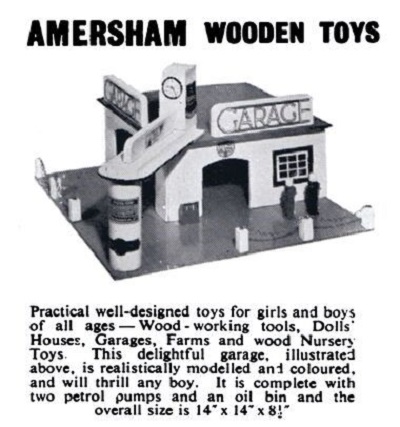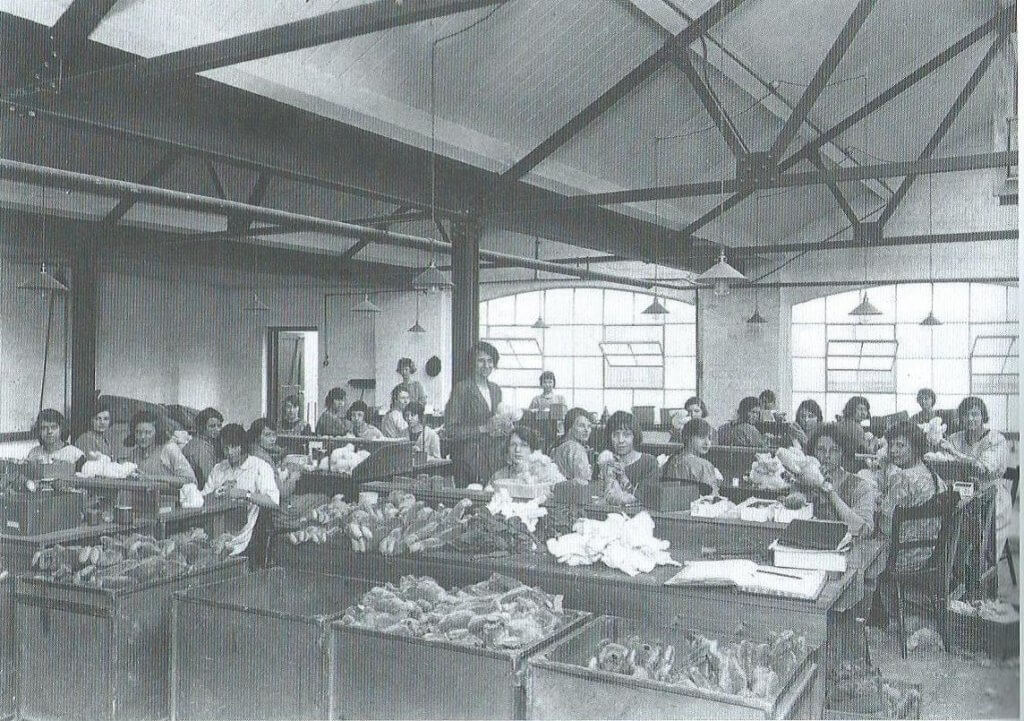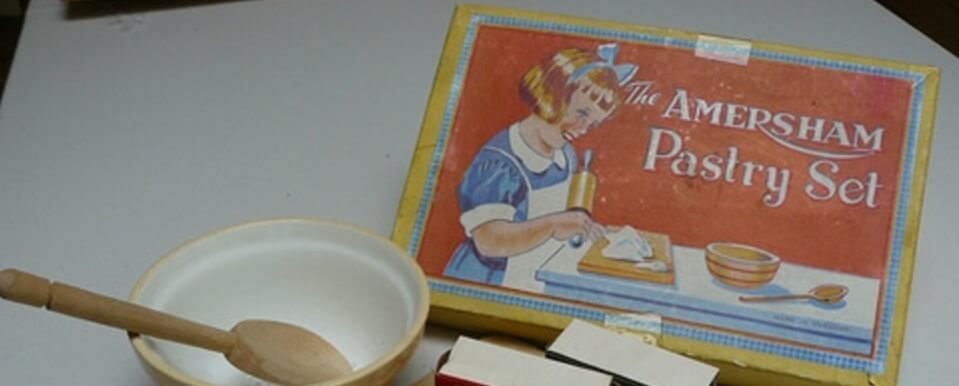The first section of this webpage is a new article, further down you can find the original one.
Click for the original article
Amersham’s Toy Story
by Alison Bailey January 2022
Inspired by our Christmas tradition of gifting toys to children, I have taken a look at Amersham’s long association with the toy industry.
Toy Shops

The town has always been well served by shops selling toys and games. The Daisy Shop at 43-45 High Street Old Amersham, sold wooden toys for over 50 years until it closed in the 1970s. Also in the High St, Ring o’ Roses, founded in 1990, still sells high quality, traditional children’s toys and hand painted, personalised nursery furniture, made in their own workshop.
However, Amersham has a particular claim to fame in the history of toys, as the birthplace of The Entertainer, now the UK’s largest independent toy retailer. The Entertainer began in May 1981, when newlyweds Gary and Catherine Grant took over the Pram and Toy Bar (where Waterstones is today) in Sycamore Road. The previous owners were not particularly welcoming to children and the Grants saw an opportunity to make the shop fun for both children and adults, where they would be ‘entertained’, and want to return.
Chiltern Toys
However, the area has an earlier association with the toy industry. Chesham wooden ware factories made toys throughout the 20th Century. Amersham Toys was one of the brand names, which also included Chiltern Toys, used by expatriate Jewish Germans, Josef Eisenmann and Leon Rees, based here. Eisenmann & Co was founded in 1880 to import fancy goods and toys from Germany and Leon Rees joined the firm in London after marrying Eisenmann’s eldest daughter Maud.
In 1908, Rees approached the English toy manufacturers, J K Farnell & Co, and persuaded them to manufacture his designs for soft toys. Around this time, Eisenmanns invested in the Chesham brush manufacturers Messrs Beechwood Ltd. They converted part of the factory at 101 Bellingdon Road to toy manufacturing, initially producing dolls for the London Evening News. Both Eisenmann and Rees were then living in Belsize Park, Hampstead, although the Rees family later moved to Northwood.
More soft toys were introduced, and then teddy bears in 1915. Former United States President “Teddy” Roosevelt inspired the name of these following a 1902 political cartoon in the Washington Post, featuring a bear hunt. The Chiltern Toys “Hugmee” bear was introduced in 1923 and became a bestseller.
Josef Eisenmann died in 1920 and Leon Rees, who inherited the business, went into partnership with Harry Stone, a friend from J K Farnell & Co. Operating as H G Stone & Co the new partnership built a bigger factory, the Amersham Woodware and Sports Works at the junction of Moor Road and Amersham Road in Waterside. The Bellingdon Road factory was retained as a warehouse. Further factories were added as the company expanded.
The 1930s

During the 1930s, the Amersham Works employed 120 people (including many women who did most of the finishing work) and was managed by Charles Brighton. A wide range of goods was produced including trouser presses, children’s nursery furniture, toys and sports equipment, such as cricket bats and tennis rackets. 600 tennis rackets were dispatched weekly in 1931. There were toy prams, enamelled in bright colours, and a range of enamelled pedal cars with backrests and nickel-plated fittings. Also available was a full size ‘Oak Nursery Set in Jacobean style’. Toys included bagatelles, castles, farmsets, trainsets, swings, playpens and miniature cake stands! Metal parts were produced in a subsidiary company in Birmingham.
In 1951, a local journalist spent the afternoon at the factory and was suitably impressed: “the toymaker takes the world as a pattern and Amersham Works are open to reproduce innumerable articles of daily life in miniature for the children: copy them faithfully, make them strongly, and finish them admirably. As three examples, the wheelbarrow, the delivery van, and the desk and stool. Here is father’s wheelbarrow exactly reproduced for the tiny tot: shape, finish, strength, the one difference, size. There a delivery van: the child sees about the streets as an item of everyday life the van: father brings him home an exact copy: shape, colouring, and lettering. Desk and stool are life-like, and if the child fancies father’s desk or a school desk, here it is. The familiar things in life are Mr Brighton’s models. Cheap and shoddy is not his line: reasonable price, sound construction and ideas in design are distinctly his line”.
Amersham Toys
The Amersham brand name seems to have been reserved for wooden toys, particularly farm sets, toy garages, doll’s houses and doll’s house furniture. In 1931 a “delicate shade of blue caught Her Majesty the Queen’s eyes at the British Industries Fair and she promptly purchased a set of Amersham Works dolls house furniture”. The doll’s houses came in a variety of styles and inspiration also came from the local area as their ‘Metroland’ style houses were particularly popular. A range of white enamelled model metal cooking stoves was also produced under the Amersham Toys brand. These even came with their own fuel to heat the hotplates!
In the 1960s, the business and works was sold to Dunbee Combex, which was then in turn absorbed into Chad Valley. Production then ceased locally when all work was transferred to the Welsh factory.
Chesham Museum
Chesham Museum have just gone live with a lovely online exhibition on the toy company – Chiltern Toy Factory > Chesham Museum
Sources
Chesham at Work in the 20th Century, Keith Fletcher, Peter Hawkes & Lesley Perry
Category:Amersham – The Brighton Toy and Model Index
Issue 4 (Feb 2010) p 7 – Dolls’ Houses Past & Present
British Newspaper Archive, Bucks Examiner, Nov 1931
Ancestry.co.uk
Amersham toy cooker – H is for Home
This is the earlier article
Have you heard of Amersham Toys and Hugmee bears?
 In 1908, a German toymaker, Joseph Eisenmann started a new branch to make toys at the Chiltern Toy Works, Bellingdon Road, Chesham, initially making dolls but later adding a range of Teddies to their range. It was one of the first firms in the UK to make soft toys on a large scale. The factory was inherited in 1919 on Joseph’s death by his son-in-law, Leon Rees, who moved production in 1920 to Waterside in Chesham. He went into partnership with Harry Stone under the name of H G Stone & Co. A second factory began production at Tottenham in 1921. The Waterside factory commenced production of the very popular Hugmee bears in 1923. During the War, the Waterside site was taken over by David Shackman & Co who produced optical equipment and other goods for the war effort. Shackman stayed on at Waterside until 1981.
In 1908, a German toymaker, Joseph Eisenmann started a new branch to make toys at the Chiltern Toy Works, Bellingdon Road, Chesham, initially making dolls but later adding a range of Teddies to their range. It was one of the first firms in the UK to make soft toys on a large scale. The factory was inherited in 1919 on Joseph’s death by his son-in-law, Leon Rees, who moved production in 1920 to Waterside in Chesham. He went into partnership with Harry Stone under the name of H G Stone & Co. A second factory began production at Tottenham in 1921. The Waterside factory commenced production of the very popular Hugmee bears in 1923. During the War, the Waterside site was taken over by David Shackman & Co who produced optical equipment and other goods for the war effort. Shackman stayed on at Waterside until 1981.
Although there was a break in toy-making during the war at the Chesham factory, the Tottenham factory continued to make some toys. After the war, production of wooden toys and soft toys moved from Waterside to the Amersham works on Moor Road in Chesham. A large new factory was built near Pontypool in 1947 – Chesham remained the centre for production of teddy bears. At the time our pastry set was produced, the factory in Chesham was staffed almost entirely by single young ladies. Hugmee bears remained in production until 1967.
In Amersham Museum there is also a doll’s house, one of the many wooden items they produced, such as doll’s house furniture, blackboards and easels, and a range of sports goods. At one time the factory employed 120 people and despatched some 600 tennis rackets each week. They also produced a range of wheeled toys, such as dolls’ pushchairs, pedal cars, wheelbarrows and stuffed animals on wheels.

It was, however, for the ‘Hugmee’ bears that the company was most famous. When a new factory was opened in Tottenham, a ‘Silky Teddy’ was brought out, and then a ‘Chubby’ bear complete with voice box, and a fawn plush ‘Cubby’ bear. Later the design of bears evolved, with longer shaved muzzles, and a variety of coloured fur – blue and pink. Later bears were provided with a growling noise, or squeakers or bellows-style music boxes.

 In the British Industries Fair in 1947, the company was listed as manufacturers of ”Chiltern” Toys, “Hugmee” Teddy Bears and Plush Animals. “Panurge Pets” and animals on Wheels, Sheepskin Toys and Cuddly Dolls and in 1960, the company featured in Good Housekeeping.
In the British Industries Fair in 1947, the company was listed as manufacturers of ”Chiltern” Toys, “Hugmee” Teddy Bears and Plush Animals. “Panurge Pets” and animals on Wheels, Sheepskin Toys and Cuddly Dolls and in 1960, the company featured in Good Housekeeping.
When Leon Rees died in 1963 the factory was taken over by another group, which in 1967 became a subsidiary of Chad Valley. Subsequently, Chad Valley became part of the Sainsbury Group.
It is interesting to note that there were several toymakers long before this, including Chesham Wooden Toy Works and the Happy Day Toy Company in Severalls Avenue (off the Berkhamsted Road).

